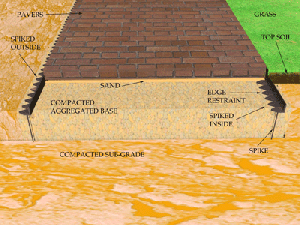Interlocking concrete pavers do not require any mortar or concrete to install — they are simply installed over a compacted, crushed-rock base topped with one inch of sand. An edge-restraint of concrete, wood, or pvc plastic edging is used around the perimeter of the installation to keep the pavers in place. After the pavers are laid on the sand, they are usually vibrated with a plate compactor (available from most local rental yards) to begin the locking process. Sand is then brushed into the spaces between the pavers and a final pass is made with the plate compactor.

This means of installation results in a “flexible” paving system that is not subject to the cracking frequently seen in poured concrete. Many areas of California have expansive soils that swell when wet and shrink as they dry. This type of soil wreaks havoc with traditional paving methods as evidenced by the numerous visible cracks often seen in poured concrete driveways and patios. In contrast, the concrete pavers are able to accommodate this natural soil movement.
For a detailed discussion of proper installation techniques, please review the Interlocking Concrete Paver Institute’s technical note here:
- D-I-Y Paver Installation Instructions: D-I-Y Paver Installation
- ICPI Tech Spec Number 2: Construction of Interlocking Concrete Pavements
Our sales office has a wealth of additional installation information available upon request. Please contact our sales office if we can assist you with your project.
ICPI Tech Specs
- Tech Spec 1: Glossary of Terms Used in the Production, Design, Construction and Testing of Interlocking Concrete Pavement
- Tech Spec 2: Construction of Interlocking Concrete Pavements
- Tech Spec 3: Edge Restraints for Interlocking Concrete Pavements
- Tech Spec 4: Structural Design of Interlocking Concrete Pavement for Roads and Parking Lots
- Tech Spec 5: Cleaning and Sealing Interlocking Concrete Pavement
- Tech Spec 6: Reinstatement of Interlocking Concrete Pavements
- Tech Spec 7: Repair of Utility Cuts using Interlocking Concrete Pavers
- Tech Spec 8: Concrete Grid Pavements
- Tech Spec 9: Guide Specification for the Construction of Interlocking Concrete Pavement – Section 02780
- Tech Spec 10: Application Guide for Interlocking Concrete Pavements
- Tech Spec 11: Mechanical Installation of Interlocking Concrete Pavements
- Tech Spec 12: Snow Melting Systems for Interlocking Concrete Pavements
- Tech Spec 13: Slip and Skid Resistance of Interlocking Concrete Pavements
- Tech Spec 14: Concrete Paving Units for Roof Decks
- Tech Spec 15: A Guide for the Construction of Mechanically Installed Interlocking Concrete Pavements
- Tech Spec 16: Achieving LEED Credits with Segmental Concrete Pavement
- Tech Spec 17: Bedding Sand Selection for Interlocking Concrete Pavements in Vehicular Applications
- Tech Spec 18: Construction of Permeable Interlocking Concrete Pavement Systems
- Tech Spec 19: Design, Construction, and Maintenance of Interlocking Concrete Pavement Crosswalks
- Tech Spec 20: Construction of Bituminous-Sand Set Interlocking Concrete Pavement
- Tech Spec 21: Capping and Compression Strength Testing Procedures for Concrete Pavers
- Tech Spec 22: Geosynthetics for Segmental Concrete Pavements
- Tech Spec 23: Maintenance Guide for Permeable Interlocking Pavers
- Tech Spec 25: Construction Guidelines for Segmental Concrete Paving Slabs and Planks in Non-Vehicular Residential Applications
